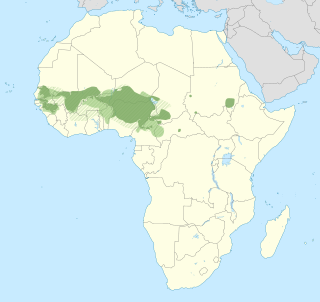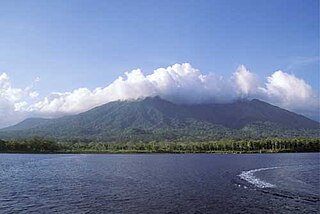Related Research Articles

Titan is the largest moon of Saturn and the second-largest in the Solar System. It is the only moon known to have an atmosphere denser than the Earth's, and is the only known object in space other than Earth on which clear evidence of stable bodies of surface liquid has been found. Titan is one of the seven gravitationally rounded moons of Saturn and the second-most distant among them. Frequently described as a planet-like moon, Titan is 50% larger than Earth's Moon and 80% more massive. It is the second-largest moon in the Solar System after Jupiter's moon Ganymede, and is larger than Mercury, but only 40% as massive due to Mercury being made of mostly dense iron and rock, while a large portion of Titan is made of less-dense ice.

Rhea is the second-largest moon of Saturn and the ninth-largest moon in the Solar System, with a surface area that is comparable to the area of Australia. It is the smallest body in the Solar System for which precise measurements have confirmed a shape consistent with hydrostatic equilibrium. It was discovered in 1672 by Giovanni Domenico Cassini.

Tethys, or Saturn III, is the fifth-largest moon of Saturn, measuring about 1,060 km (660 mi) across. It was discovered by Giovanni Domenico Cassini in 1684, and is named after the titan Tethys of Greek mythology.

Iapetus is the outermost of Saturn's large moons. With an estimated diameter of 1,469 km, it is the third-largest moon of Saturn and the eleventh-largest in the Solar System. Named after the Titan Iapetus, the moon was discovered in 1671 by Giovanni Domenico Cassini.

Enceladus is the sixth-largest moon of Saturn and the 19th-largest in the Solar System. It is about 500 kilometers in diameter, about a tenth of that of Saturn's largest moon, Titan. It is mostly covered by fresh, clean ice, making it one of the most reflective bodies of the Solar System. Consequently, its surface temperature at noon reaches only −198 °C, far colder than a light-absorbing body would be. Despite its small size, Enceladus has a wide variety of surface features, ranging from old, heavily cratered regions to young, tectonically deformed terrain.

The moons of Saturn are numerous and diverse, ranging from tiny moonlets only tens of meters across to the enormous Titan, which is larger than the planet Mercury. There are 146 moons with confirmed orbits, the most of any planet in the solar system. This number does not include the many thousands of moonlets embedded within Saturn's dense rings, nor hundreds of possible kilometer-sized distant moons that were seen through telescopes but not recaptured. Seven Saturnian moons are large enough to have collapsed into a relaxed, ellipsoidal shape, though only one or two of those, Titan and possibly Rhea, are currently in hydrostatic equilibrium. Three moons are particularly notable. Titan is the second-largest moon in the Solar System, with a nitrogen-rich Earth-like atmosphere and a landscape featuring river networks and hydrocarbon lakes. Enceladus emits jets of ice from its south-polar region and is covered in a deep layer of snow. Iapetus has contrasting black and white hemispheres as well as an extensive ridge of equatorial mountains among the tallest in the solar system.

Clavius is one of the largest crater formations on the Moon and the second largest crater on the visible near side. It is located in the rugged southern highlands of the Moon, to the south of the prominent ray crater Tycho. It is named for the Jesuit priest Christopher Clavius.

Fula, also known as Fulani or Fulah, is a Senegambian language spoken by around 36.8 million people as a set of various dialects in a continuum that stretches across some 18 countries in West and Central Africa. Along with other related languages such as Serer and Wolof, it belongs to the Atlantic geographic group within Niger–Congo, and more specifically to the Senegambian branch. Unlike most Niger-Congo languages, Fula does not have tones.

Baluan Island is the southernmost island of the Admiralty Islands group which makes up the majority of Manus Province in Papua New Guinea. It belongs to the Pam Islands, an island subgroup to the south of Lou Island. It is formed from an extinct volcano, also named Baluan.

Ceres is a dwarf planet in the middle main asteroid belt between the orbits of Mars and Jupiter. It was the first known asteroid, discovered on 1 January 1801 by Giuseppe Piazzi at Palermo Astronomical Observatory in Sicily, and announced as a new planet. Ceres was later classified as an asteroid and then a dwarf planet, the only one inside Neptune's orbit.

Long Island is a populated volcanic island in Madang Province, Papua New Guinea. It is located north of the island of New Guinea, separated from it by the Vitiaz Strait. The island's interior contains a 360m deep freshwater volcanic crater lake and within that lake exists an even smaller island known as Motmot island. During the late 17th or early 18th century virtually all of the biota on the island was destroyed and has subsequently provided scientists a unique opportunity to study recolonization efforts by plants, animals, and humans. The vast majority of the buildings on the island are constructed using vernacular architecture.
Tifal is an Ok language spoken in Papua New Guinea. Dialects are Tifal (Tifalmin), Urap (Urapmin) and Atbal (Atbalmin).
Afek is a mythic heroine in the religion of the Min peoples living in Sandaun Province of Papua New Guinea.

Mons is a mountain on a celestial body. The term is used in planetary nomenclature: it is a part of the international names of such features. It is capitalized and usually stands after the proper given name, but stands before it in the case of lunar mountains.

PateraPAT-ər-ə is an irregular crater, or a complex crater with scalloped edges on a celestial body. Paterae can have any origin, although the majority of them were created by volcanism. The term comes from Latin, where it refers to a shallow bowl used in antique cultures.

Dragonfly is a planned NASA mission to send a robotic rotorcraft to the surface of Titan, the largest moon of Saturn. It is planned to be launched in July 2028 and arrive in 2034. It would be the first aircraft on Titan and is intended to make the first powered and fully controlled atmospheric flight on any moon, with the intention of studying prebiotic chemistry and extraterrestrial habitability. It would then use its vertical takeoffs and landings (VTOL) capability to move between exploration sites.
Telefomin Rural LLG is a local-level government (LLG) of Sandaun Province, Papua New Guinea. Mountain Ok languages are spoken in the LLG.
References
- ↑ Wheatcroft, Wilson (1973). "Tifalmin". Primitive Worlds: People Lost in Time. Washington, D.C.: National Geographic Society. ISBN 978-0-87044-127-1.
- 1 2 Swadling, Pamela; Wagner, Roy; Laba, Billai (2019). Plumes from Paradise (PDF). Sydney University Press. ISBN 9781743325445.
- ↑ MacKenzie, Maureen A. (25 January 2019). Androgynous Objects: String Bags and Gender in Central New Guinea. Routledge. ISBN 978-1-317-70486-7.
- ↑ "Afekan". We Name The Stars. Archived from the original on 2019-11-02. Retrieved 2020-07-09.
- ↑ "Name Approved for Crater on Titan". USGS Astrogeology Science Center. 2008-08-04. Retrieved 2020-07-09.